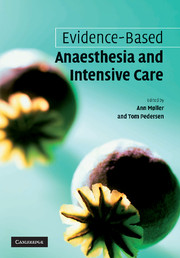Book contents
- Frontmatter
- Contents
- Foreword
- Contributors
- 1 Introducing evidence-based anaesthesia
- 2 How to define the questions
- 3 Developing a search strategy, locating studies and electronic databases
- 4 Retrieving the data
- 5 Critical appraisal and presentation of study details
- 6 Outcomes
- 7 The meta-analysis of a systematic review
- 8 Bias in systematic reviews: considerations when updating your knowledge
- 9 The Cochrane Collaboration and the Cochrane Anaesthesia Review Group
- 10 Integrating clinical practice and evidence: how to learn and teach evidence-based medicine
- 11 Involving patients and consumers in health care and decision-making processes: nothing about us without us
- 12 Evidence-based medicine in the Third World
- 13 Preoperative anaesthesia evaluation
- 14 Regional anaesthesia versus general anaesthesia
- 15 Fluid therapy
- 16 Antiemetics
- 17 Anaesthesia for day-case surgery
- 18 Obstetrical anaesthesia
- 19 Anaesthesia for major abdominal and urological surgery
- 20 Anaesthesia for paediatric surgery
- 21 Anaesthesia for eye, ENT and dental surgery
- 22 Anaesthesia for neurosurgery
- 23 Cardiothoracic anaesthesia and critical care
- 24 Postoperative pain therapy
- 25 Critical care medicine
- 26 Emergency medicine: cardiac arrest management, severe burns, near-drowning and multiple trauma
- Glossary of terms
- Index
14 - Regional anaesthesia versus general anaesthesia
Published online by Cambridge University Press: 05 September 2009
- Frontmatter
- Contents
- Foreword
- Contributors
- 1 Introducing evidence-based anaesthesia
- 2 How to define the questions
- 3 Developing a search strategy, locating studies and electronic databases
- 4 Retrieving the data
- 5 Critical appraisal and presentation of study details
- 6 Outcomes
- 7 The meta-analysis of a systematic review
- 8 Bias in systematic reviews: considerations when updating your knowledge
- 9 The Cochrane Collaboration and the Cochrane Anaesthesia Review Group
- 10 Integrating clinical practice and evidence: how to learn and teach evidence-based medicine
- 11 Involving patients and consumers in health care and decision-making processes: nothing about us without us
- 12 Evidence-based medicine in the Third World
- 13 Preoperative anaesthesia evaluation
- 14 Regional anaesthesia versus general anaesthesia
- 15 Fluid therapy
- 16 Antiemetics
- 17 Anaesthesia for day-case surgery
- 18 Obstetrical anaesthesia
- 19 Anaesthesia for major abdominal and urological surgery
- 20 Anaesthesia for paediatric surgery
- 21 Anaesthesia for eye, ENT and dental surgery
- 22 Anaesthesia for neurosurgery
- 23 Cardiothoracic anaesthesia and critical care
- 24 Postoperative pain therapy
- 25 Critical care medicine
- 26 Emergency medicine: cardiac arrest management, severe burns, near-drowning and multiple trauma
- Glossary of terms
- Index
Summary
The question whether regional anaesthesia improves postoperative morbidity and mortality is complex. The answer would differ depending on the patient, the surgery, the method of regional and general anaesthesia, and the quality of perioperative care. We will start this chapter by discussing issues that construct the complexity of this question, such as heterogeneity and discrepancy between old and recent trials. Then we will assess current evidence of regional versus general anaesthesia on selected specific topics – hip fracture surgery, carotid endarterectomy, Caesarean section, ambulatory orthopaedic surgery, and postoperative cognitive dysfunction in elderly patients after non-cardiac surgery.
Introduction
The debate over the theoretical superiority of regional over general anaesthesia has persisted throughout most of the twentieth century, and there is still no satisfactory answer to the question of whether avoidance of general anaesthesia saves lives or reduces morbidity. But the answer eludes us only because the question is complex, and there is probably no simple answer. Multiple factors, including the patient's health status, the surgical procedure, choice of regional anaesthetic, whether regional is combined with general anaesthesia, and exact choice of general anaesthetic, influence outcome and effect the balance of benefits and risks. Moreover, changes occur in clinical practice over time that have an important effect on outcome, and often alter the balance of benefit between regional and general anaesthesia.
Keywords
- Type
- Chapter
- Information
- Evidence-based Anaesthesia and Intensive Care , pp. 135 - 150Publisher: Cambridge University PressPrint publication year: 2006



